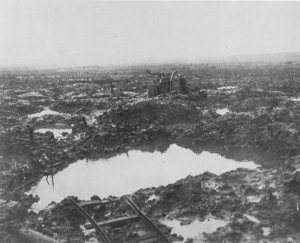
On 31st July 1916, a Medical Board at Oxford pronounced Cecil still unfit for service and granted him 8 weeks leave to recover from the wound inflicted at Serre. By the time of his next Medical Board on 2nd September he was considered to be fit for home service, and two days later Cecil re-joined the 10th Battalion at Wareham. It was also in September that Bert was recommended for a commission while serving on the Western Front, and in December he was transferred to England for admission to Officer Cadet School. Ernest had gone out to France with the RFC in December 1915 and in all probability was still serving there - as mechanic and pilot - a year later1. And now a fourth brother had entered the war; immediately on leaving Caterham in the early summer of 1916, Fred too had joined the RFC for pilot training. In November 1916, having completed his course of instruction, Fred was posted to 16 Squadron on the Western Front flying BE2c and BE2d reconnaissance aircraft. Tragedy struck the family in the spring of 1917. A telegram delivered to Eastbrook End broke the news that Fred had died of wounds on 25th March. The BE2s were notoriously vulnerable in aerial combat and as early as 1915 were regarded as "Fokker fodder". Fred was fatally wounded in an action on 24th March but still managed to land his plane, saving the life of his observer 2/Lt. Arthur Baerlein2. Cecil remained at Wareham until the autumn of 1917 when he was again posted to the Western Front. On 18th September, he reported for duty with the 1st Battalion, just before it moved up in preparation for the next phase of the offensive at Ypres - the Battle of Broodseinde. The battle was launched at 6am on 4th October by the Second and Fifth Armies on an 8-mile (13km) front extending from west of Poelcapelle to just south of the Menin Road west of Gheluvelt. Broodseinde has been referred to as the battle "which nobody has ever heard of" and yet by any standards it was a resounding success for the ANZAC and British forces. The task allocated to the main body of the 1st East Lancashires - "A", "B" and "D" Companies - was to support the attack of the 1st Hampshires and 1st Somerset Light Infantry close to the left flank of the battle front. From the remaining "C" Company two platoons - one of which was led by Cecil Gay - were placed under the command of the O.C. 1st Somerset Light Infantry to maintain contact with the next battalion in line, the 9th Sherwood Foresters.  In the darkness of 6am the leading battalions moved forward under the cover of a creeping artillery barrage. The Somersets overran the German front line with ease and reached the track running south from Lemnos House before being held up by enemy fire. On the battalion's left a machine gun at Lemnos House was knocked out by rifle fire and rifle grenades. On the right the advance had stalled in the face of heavy machine gun fire from a concrete emplacement on the south side of the Langemarck-Poelcapelle road. Covered by Lewis gun fire, men from the Somersets and Sherwood Foresters took the emplacement in a flanking attack, capturing two machine guns. Both the Somersets and Sherwood Foresters were now coming under intense fire from Ferdan House. The barrage was halted for a while as preparations were made to take the attack forward. Lewis guns and a Stokes mortar were brought to bear on the fortified building before the barrage and the advance were renewed. The detachment from "C" Company of the East Lancashires worked round the right flank while the Somersets went round the left. During an action in which Cecil Gay won the Military Cross, Ferdan House was taken along with prisoners, machine guns and trench mortars.
As the Somersets pressed on towards their objective, Cecil's platoon was probably left to escort the prisoners back to the British lines.
After the Battle of Broodseinde, the 1st East Lancashires were withdrawn to the Arras sector and played no further part in the Ypres offensive3.
|

